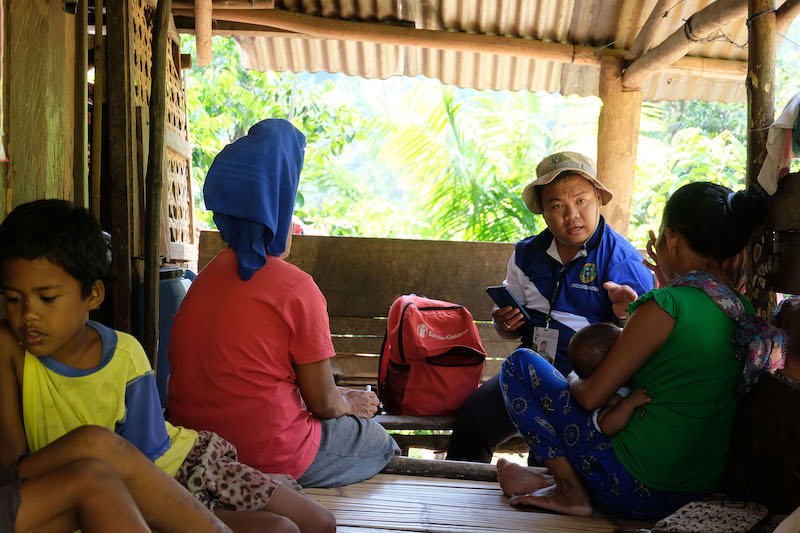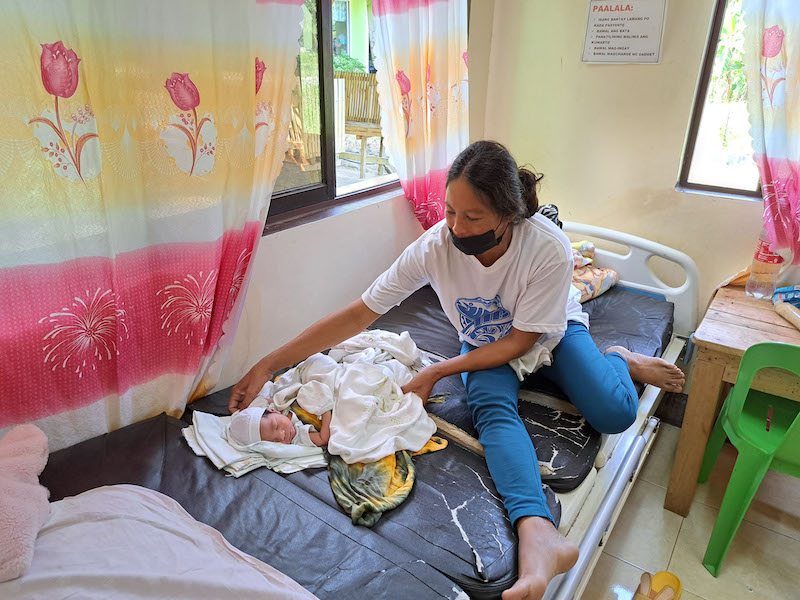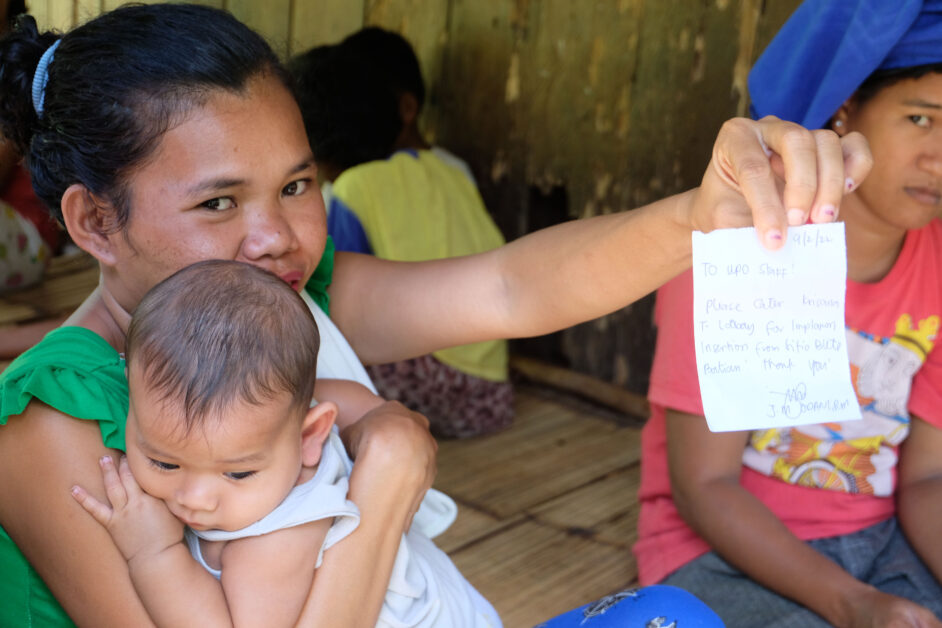MAITUM, Sarangani (MindaNews / 18 September) — Louie Manuel came out of his mother’s womb 10 years ago inside their nipa hut in Barangay Bati-an, a geographically isolated and disadvantaged area (GIDA), without any help from a hilot (traditional birth attendants) or fesut nga in the language of the T’bolis.
Mary Grace, who has a speech problem, gave birth to a healthy baby boy, her firstborn, now a Grade 5 student in a public school here.
She delivered at home despite a national policy that prohibits giving birth at home.
In 2008, the Philippines implemented the Maternal, Newborn and Child Health and Nutrition Strategy policy, otherwise known as the “no home birth policy“ to rapidly reduce maternal and newborn morbidity and mortality in the country.
“Nasorpresa mi, wa mi kalibutan na nanganak na siya (We were surprised and shocked to know that the baby had come out,” said Simeon Cabulat, Louie’s grandfather.
The cry of the newborn baby and the call for help of Mary Grace awakened the household.
Seeing that the newborn’s umbilical cord was still connected to her mother’s placenta, Cabulat looked for his sharp knife and cut it off without any hesitation. According to Cabulat, he and his nine siblings were safely delivered by the hilot who used herbal medicines from the forest during deliveries and postnatal care to make sure mother and child are safe and healthy. A broth of boiled roots and herbs, called bulung bleten, is served to the mother after giving birth for her speedy recovery.
 Simeon Cabulat, a T’boli, holds the knife he used in cutting his grandchild’s umbilical cord when daughter Mary Grace (right) delivered Louie Manuel on 2 September 2022. MindaNews photo by BONG S. SARMIENTO
Simeon Cabulat, a T’boli, holds the knife he used in cutting his grandchild’s umbilical cord when daughter Mary Grace (right) delivered Louie Manuel on 2 September 2022. MindaNews photo by BONG S. SARMIENTO
Mary Grace followed her elder’s practices, shunning prenatal care services due to poverty. If she had availed of these services, however, she would have known when her baby would come out. Also, there was no midwife then who went around their far-flung community regularly. To get to the poblacion of Maitum, they have to cross a river and pay at least P100 one way for a habal-habal (motorcycle) ride per person from their community in Sitio Blete, one of the six sitios in Barangay Bati-an.
The day after she gave birth, family members brought Mary Grace and the baby to the rural health unit (RHU) in the población to avail of proper maternal and child care services from the local government unit (LGU).
There, she was made aware about the importance of pre- and post-natal care.
Far and poor community
John Mark Odani, a volunteer health worker, has been serving Barangay Bati-an, a barangay populated by the indigenous T’boli, and one of the poorest villages of Maitum for nearly a decade now, sometime after Mary Grace gave birth to her firstborn in 2012.
With her awareness on prenatal care and the deployment of Odani to their village, Mary Grace delivered her two succeeding babies in one of the three birthing facilities operated by the LGU, with duly registered nurses and midwives. The birthing facilities are found in the población of Maitum, in Barangay Upo and in Barangay Maguling. The birthing centers in the población of Maitum and Barangay Upo are the nearest from Bati-an, with a fare of at least P100 per head for the shortest route.
 John Mark Odani, a registered midwife working at the rural health unit of Maitum in Sarangani, crosses the Kalaong River after visiting Sitio Blete, Barangay Bati-an on 2 September 2022. MindaNews photo by BONG S. SARMIENTO
John Mark Odani, a registered midwife working at the rural health unit of Maitum in Sarangani, crosses the Kalaong River after visiting Sitio Blete, Barangay Bati-an on 2 September 2022. MindaNews photo by BONG S. SARMIENTO
Odani, an Ilocano from a poor family, was a fresh graduate then of a two-year nursing aide course when he volunteered to serve in Bati-an, a least-favored assignment due to its distant location and terrible state of the roads. Reaching the village requires crossing the river a handful of times. Bati-an straddles six sitios in the hinterlands.
“Sa sobrang layo, napaiyak ako noon” (Its distance really made me cry before),” he recalled.
He persevered and began to love his work, getting a sense of unexplainable high on delivering health services to the neglected and poverty-stricken members of the T’boli.
Odani regularly visited Sitio Angko, Barangay Bati-an’s farthest community where a Philippine Eagle (Pithecophaga jefferyi) has been sighted, to conduct immunization, prenatal care and family planning services.
After some time, he applied for a scholarship funded by the Sarangani provincial government, took up midwifery and passed in 2015.
Odani returned to Maitum and asked to be assigned back to Barangay Bati-an. He also learned to speak the T’boli language to effectively communicate with them.
He worked as a job order or contractual employee and got a regular position only in September 2020.
While there was resistance, initially, at delivering babies in birthing facilities, Odani managed to convince pregnant women in Barangay Bati-an that doing so is safer for both mother and child. His regular visits and his dedication to educate the different communities scattered far and few between about the importance of availing proper natal care services, eventually convinced them.
Their campaign to deliver babies at the birthing center is a continuing effort since there are still women who give birth at home especially those in farflung areas. Some of the town’s communities in the mountains are accessible only by foot.
 Midwife John Mark Odani at work with the housewives in Sitio Blete, Barangay Bati-an, Maitum, Sarangani on 2 September 2022. MindaNews photo by BONG S. SARMIENTO
Midwife John Mark Odani at work with the housewives in Sitio Blete, Barangay Bati-an, Maitum, Sarangani on 2 September 2022. MindaNews photo by BONG S. SARMIENTO
Based on the local health office’s data, there were 25 deliveries at the birthing center in poblacion Maitum in 2021. Called the George Y. Yabes Maternity Home, in honor of its murdered mayor, it was designated a COVID-19 isolation center until the first quarter of 2022. When it was opened again for deliveries, 86 babies were born there as of September 14.
At the Upo birthing center, 184 babies were born in 2021 and 115 since January 2022.
At least 292 babies were delivered at the Maguling birthing facility in 2021 and 212 for this year.
Odani says he cannot count how many children he has delivered in the town’s birthing facilities. But aside from delivering babies, he also does immunization, checks on the community for ordinary illnesses such as cough and fever, advocates for zero open defecation and promotion of environment awareness.
Fondly called Marky, Odani, who is openly gay, has a way with the T’boli, especially the mothers who listen to his maternity health advices and feel comfortable with him delivering their babies.
For his exemplary work, Odani was conferred the 14th Gawad Geny Lopez Bayaning Kabataang Pilipino Award in 2017.
Odani said he did not expect the award but was grateful for the recognition.
“When you love your job, you will enjoy it – and that’s what matters the most,” the 31-year-old midwife stressed.
Maitum town, which has a population of 44,185 as of the May 2020 census, has 19 barangays, three of them classified as GIDA, including Bati-an with a population of 1,069 as of the 2020 census, according to the Philippine Statistics Authority.
Each village also has assigned nurses, thanks to the program of the Department of Health – Human Resource for Health (DOH-HRH). Of the 19 nurses, only one is under the employ of Maitum town while the rest are from the DOH-HRH.
Only seven of the 19 midwives are regular employees of the municipal health office.
Dr. Marilyn Silauso, acting municipal health officer, admitted that the LGU has limited resources for the hiring of nurses and midwives.
The RHU does not accept patients for admission due to lack of rooms. Instead, it refers patients to the nearby hospital owned by the Sarangani provincial government.
“Aside from medical check-up and dental service, RHU Maitum has laboratory facilities that can be availed of for free by our clients,” Silauso said.
Regular community presence
Odani regularly goes to his assigned area at least once a week. He is an expert on providing prenatal care to pregnant women. He also teaches family planning to the T’boli. His backpack always contains medicines for ordinary illnesses in case constituents ask for these.
Because of his steady presence in Barangay Bati-an, the LGU managed to stop the practice of women in the village relying on hilots to deliver their babies.
“The pregnant women would go to our birthing centers on their expected due dates,” Odani said.
For maternity services, Maitum town operates three birthing facilities – in the población, in Barangay Upo and in Barangay Maguling.
Pregnant women, even from neighboring towns, can choose which birthing facility they would deliver their babies.
Members of the state-owned Philippine Health Insurance Corp. (PhilHealth) or indigent patients can give birth for free in these facilities.
Safe and convenient
Analita Dingly, 39, gave birth to a healthy baby boy at around 6:05 p.m. on September 1, her sixth child. She delivered her first three children at their home with the help of a hilot, whom she paid P500 for her service.
Dingly recovered the day after she gave birth at the birthing facility in Barangay Upo. Beside her was a woman who had just given birth also, the latter looking strong and healthy along with her baby.
“I want to go home. I feel strong already. My baby is alive and kicking,” Dingly said in Filipino.
However, the mother and her newborn need to be observed for 24 hours before they can be discharged from the birthing center.
Compared to giving birth at home with the help of a hilot, Dingly noted that delivering at the birthing facility is convenient and safer both for the mother and the baby.
“There’s a midwife and a nurse making sure that we’re in good condition. My recovery here is fast because of the medication,” she said.
 Analita Dingly attends to her newborn baby boy at the birthing facility in Barangay Upo, Maitum, Sarangani. The baby was born at 6:05 p.m. on 1 September 2022. MindaNews photo by BONG S. SARMIENTO
Analita Dingly attends to her newborn baby boy at the birthing facility in Barangay Upo, Maitum, Sarangani. The baby was born at 6:05 p.m. on 1 September 2022. MindaNews photo by BONG S. SARMIENTO
Dingly needs to shell out only P50 for the processing of her birth certificate.
On family planning, midwife Odani often emphasizes spacing births and if possible, plan the size of the family to ensure the children’s needs are addressed.
“Considering that many of the Tboli’s are poor, they will have more difficulty addressing the family’s needs if they have more children,” he explained.
Crisana Lambay, 29, wife of a farmer, heeded the advice of Odani.
She gave birth four months ago to her third child, a boy. Her two other children are aged six and two.
Odani handed her a note, asking the maternity facility to accommodate her request for implanon insertion, a birth control method that could last for three years.
 Crisana Lambay shows off the handwritten note of midwife John Mark Odani for her request to have an implanon insertion, a birth control method, during the latter’s visit to Sitio Blete, Barangay Bati-an on 2 September 2022. MindaNews photo by BONG S. SARMIENTO
Crisana Lambay shows off the handwritten note of midwife John Mark Odani for her request to have an implanon insertion, a birth control method, during the latter’s visit to Sitio Blete, Barangay Bati-an on 2 September 2022. MindaNews photo by BONG S. SARMIENTO
“It’s difficult to have many children. We are practicing birth control so that our eldest child can go to school,” said Lambay while cradling her baby.
For the T’boli in Barangay Bati-an, the regular presence of midwife Odani in their midst is a big relief.
“We can feel the presence of the government with his presence in our community. We are thankful for his work and dedication even if we are far from the town center,” said Cabulat, Louie’s grandfather.
Odani stressed he will not get tired helping the T’boli mothers receive proper pre- and post-natal care, and attending to the other health needs of the T’boli.
“We must strive to make a difference in the lives of those in last mile communities. If they can’t come down to avail (of services), let us bring basic government health services to them,” he said. (Bong S. Sarmiento / MindaNews)
(This report was produced through a story grant from the Philippine Press Institute under the auspices of the Hanns Seidel Foundation. The theme of the journalism fellowship is Governance and Health)
